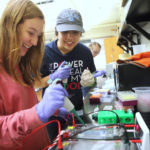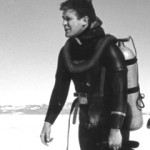Author: John Bruno
-

Cycling through a climate apocalypse
Even though it’s mid-day, it’s eerily dark outside. Since the light is so diffuse, there are no shadows on the ground. I’m biking up a steep mountain trail in central Montana and, through the smoke from a nearby fire, the sun is deep orange. It burns my throat and nostrils, but the larger effect is…
-
A case for evidence-based reef conservation
Like forests formed by trees, tropical coral reefs are built up by corals over thousands of years via the slow accumulation of their skeletons. Corals – related to jellyfishes and sea anemones – provide shelter to countless other species, including the fishes we travel to see and love to eat. But corals and coral reefs…
-

This week in seafood mislabeling
When you teach a class on seafood forensics, your friends and family send you lots of stories about seafood mislabeling in the media. And this week there were some good ones. First, news that a supplier of Chesapeake blue crab was actually selling…
-
In support of the Biscayne Bay marine reserve
The ongoing battle over the planned marine reserve in Biscayne Bay has scientists and citizens scratching our heads. The impassioned opposition to the proposed protection of a tiny sliver of our shared resource is stunningly out of proportion to what the National Park Service (NPS) has proposed. Moreover, the arguments made by opponents have not…
-
Response to Avigdor Abelson
The graphics below are to supplement our response to the criticisms of Avigdor Abelson about our recent paper in Scientific Reports.
-
Back to Belize
I arrived in Belize yesterday with three former lab members (Abel Valdivia from CBD, Courtney Cox from the Smithsonian, and Jenny Hughes, a recent graduate from UNC). Although field ecology is really fun (if pretty challenging) we are actually here to work. In 2008 my lab took over a reef monitoring program Melanie McField set up in the…
-
Are isolated central Pacific reefs really “healthier”?
In a new paper – that got a lot of media coverage – Smith et al 2016 quantified benthic reef composition “across 56 islands spanning five archipelagos in the central Pacific”. I think it’s an admirable project and an interesting data set, and there is a lot to like about the paper. However, some of…
-

Top 10 take-home lessons from Dayton 1971
10) Natural communities are enormously complex, often governed by networks of positive and negative indirect interactions. (complexity, indirect effects) 9) Multiple factors and processes interact to influence community assembly, including competition, predation, facilitation, recruitment, disturbance, physiological stress, patch dynamics, and succession. (multifactoralism) 8) The relative importance of various factors is highly context dependent. (AKA…
-

That wild caught shrimp you just ate? It might be from a skanky, destructive farm
Like lots of people, you probably love shrimp. Love to eat them that is. And hopefully you know, shrimp farming is highly destructive. To make a shrimp farm, you first clear out all the mangroves, destroying a critical coastal ecosystem. Mangrove loss results in greater storm and tsunami impacts, greatly reduced fisheries production (mangrove roots,…
-
Academic-NGO partnerships to optimize and utilize conservation science
Problems: (1) Many academic scientists in conservation biology are isolated from end-users of their work, including policy makers, stakeholders, and conservation NGOs (CNGOs). (2) CNGOs rely on science and scientists, however, a science staff is very expensive to maintain. Assumptions: (1) Science is valuable and useful to CNGOs. (2) Some academic scientists want to produce…